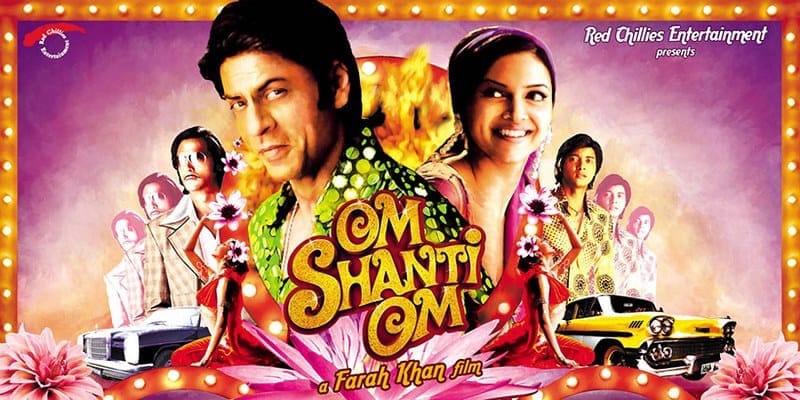Critical Analysis of a Film: Om Shanti Om

Summary
The film is a masterpiece that takes place mostly on movie sets because the main characters Om (a small-time actor) and Shanti (a famous actress) work in the movie industry, many settings and social disparities are used to invoke feelings within the viewers.
Om & Shanti falling in love with each other one-sidedly in 2 lifetimes.
In their first life: Om & Shanti's first hangout as friends, Om wishes it is something more but it is only a friendship for Shanti.
The story follows the incomplete romance from their first life into their reincarnated second life, where after regaining their memories, they plot a grand plot to get a confession out of the guy that killed them in their first life. Their killer (Mukesh) is a movie director who got Shanti pregnant in her first life. When she asked him for marriage, he burnt her and his unborn child alive to hide the scandal, in a movie set that he made for her new movie because he wanted to marry someone more influential to further his directing career. Om is mad in love with Shanti and tries to save her from the outside of the locked burning building, but the bodyguards beat him to death for getting in the way.
A small-time actor falls in love with a famous actress but he doesn't know she is committed to another, who will betray her.
Inequality, geographical representation & power
The main inequality of the movie is how insignificant Mukesh thinks Shanti is, that he thinks it is okay to go to any extreme if someone gets in the way of his career. The climax of Shanti’s death is perfectly built, some geographical representations used to portray the wealthy life they could have had together is the beautiful expensive set Mukesh takes Shanti to the set to tell her that the set will also be their wedding venue but soon goes on to explain that everything was going great but saddens him to kill her and burn the set because they were going to be at the top of the industry after this film together but she ruined his timeline because she wants to marry him and is pregnant.
The fire/music during this betrayal symbolizes the evilness and pain of the untouchable unforgiving fire that creates a great obstacle for Om to deal with to save Shanti and the night symbolizes the cover of darkness to get away with crimes, the helplessness of having no public around to ask for help because it is nighttime. The easiness of erasing 2 lives because they are too powerless to stop it.
It stands out that the power dynamics in the film are related to being influential, a man, fame, the kinds of parents you have, or how your job is viewed in society.
A tune to give you goosebumps.
Other
In Indian films, I also love the use of songs sprinkled throughout the film. I especially love it when they are used as a montage to further the development of the characters, and it is always a bonus when the song pulls at your heartstrings for being so good. The plot of this film can be told through the songs in it. An example is this song, where Om has put on a play of how the first Om and Shanti died, for Mukesh 30 years later to rejog his memories:
Interestingly, there are movie sets within the film, and it allowed the director to be creative, like making the viewers imagine a camera crew filming a camera crew or having a song/party filled with cameos of famous Indian actors, because Om in his second life is a famous actor. Here is the song:
There is a beautiful overlap in many parts of this film, like the title of the movie reminds me of the reincarnation that takes place in the film, and the hopes and desires of the first life taking shape in the second life by ‘coincidence’ of Om being reborn as a famous actor with the help of having a famous actor dad; or ‘intentionally’ where the Om uses the details of the wedding venue 30 years later to haunt on Mukesh of his crimes.
It's satisfying to notice all the overlaps in the movie, it is the only movie I can rewatch and I notice new connections in it every time. I hope reading this has made you curious enough to watch it. I would love to know your thoughts on it.
Clayton H. Riddell Faculty of Environment, Earth, and Resources, University of Manitoba
GEOG 2640: Geography of Culture and Inequality
Dr. Olga Shugurova
Member discussion